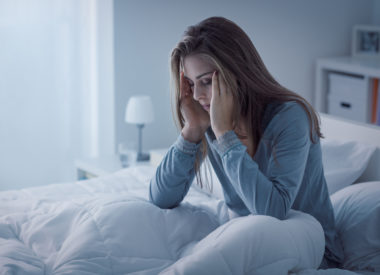COPD: Breathless and sleepless at the same time
The acronym, COPD, refers to 2 common breathing disorders: chronic bronchitis and emphysema.
Both conditions make it difficult to breathe during the day while you are awake.
At bedtime, COPD can create nearly impossible conditions for getting adequate sleep.
It can also worsen other preexisting (or undetected) sleep disorders.
A closer look at COPD
Chronic bronchitis
Bronchitis occurs any time the trachea (the windpipe) or the bronchi (the branching passages inside the lungs) become inflamed, usually as a result of infection or irritants.
Recurring bronchitis is considered chronic , and it leads to inflammation of the lining of the lungs, causing fluid to build up inside the airway.
A wet, painful cough (also known as
(“smoker’s cough”) is the signature symptom of chronic bronchitis as the body tries to eliminate these excess fluids.
Emphysema
This is a condition of the lungs in which the air sacs of the lungs (the alveoli ) fail to exchange carbon dioxide for oxygen during the process of exhalation and inhalation.
The disease causes the alveoli to weaken and collapse. This physically prevents oxygen from entering the bloodstream, leaving it trapped in spaces inside the lungs.
Both diseases tend to lead to the same clusters of symptoms, such as excessive work of breathing, generalized fatigue, chronic cough, and tightening sensations in the chest.
COPD can lead to daytime hypoxia (low levels of blood oxygen) because of imbalances in and disruptions to gas exchange (exhalation releases extra carbon dioxide from the lungs, while inhalation introduces fresh oxygen to the lungs).
Paradoxically, people with COPD have a harder time “blowing off” (exhaling) carbon dioxide because of this respiratory dysfunction. They literally stash extra gas inside their chest cavity, lacking the ability to disperse it to the blood stream (in the case of oxygen) or release it to outside the body (as with carbon dioxide) because of their weakened alveoli.
COPD rarely occurs in people under age 40, but once it takes root in the structures of the lungs, it cannot be reversed and generally progresses.
What causes COPD?
Smoking is the number one cause of COPD. Cigarette smoke destroys the structure and elasticity of the alveoli. Unfortunately, these can never be repaired or grow back.
In addition, the hair-like lining of the airway (the cilia ) is, in a sense, “burned away” by excessive smoking.You need this lining to clear fluids and trap foreign irritants so you can cough them out of your lungs. Without it, you will struggle to keep out pollutants or fight off infection.
Other causes of COPD can include inhalation of second-hand smoke, exposure to pollutants, chronic viral infections, and sometimes (though rarely) a weakened immune system or genetics.
COPD and sleep disorders
If breathing while awake is a challenge for people with COPD, trying to sleep while struggling to breathe adequately only worsens the problem. Sleep fragmentation, reduced amounts of deep sleep, and less REM sleep are all consequences of having COPD.
The symptoms of COPD make it hard to relax and fall asleep. They include:
-
coughing
-
chest pain
-
nocturia (frequent trips to the bathroom at night)
-
Skin discoloration (noticeably blue lips or overly pink cheeks)
In addition, many people with COPD must wake up in the middle of the night to treat theirCOPD as part of a medication schedule, which further disrupts sleep.
Disrupted sleep is not the only problem. According to the American Thoracic Society, people who haveCOPD also have a higher incidence of nightmares, insomnia, and daytime sleepiness when compared to the general population; nearly half of them have additional, separate sleep complaints, such as obstructive sleep apnea (OSA), restless legs, or REM behavior disorder.
In the case of someone with OSA who also has COPD, they suffer from a condition known asOverlap Syndrome, asleep breathing disorder that results from having both the breathing difficulties of COPD and the blood oxygen desaturation concerns of OSA.
As much as one percent of the entire general population suffers from Overlap Syndrome. These people tend to suffer from chronic hypoxemia , a condition of sustained low blood oxygen, which is also known to lead to the heart condition, cor pulmonale, and the blood-related bone disorder, polycythemia .
Coping with COPD
There’s no cure for COPD, but you can still find relief with medications (such as ramelteon) and lifestyle changes (such as quitting smoking ). Here are some other considerations:
Drug use: If you treat COPD with prednisone or albuterol, be warned that sleep disturbance is a common side effect for both medications. If you feel you need a sleep aid to help you fall asleep, avoid Ambien; this drug depresses respiratory function, making it even harder to breathe.
Sleeping position: This can help mediate some of the discomfort of challenged breathing at night. It’s difficult for someone with COPD to breathe while reclined flat; instead, they choose to sleep in a reclining chair or use pillows to prop them up while in bed.
Nighttime oxygen: Some patients may find they are more comfortable using supplemental oxygen, which is helpful for getting adequate sleep.
Noninvasive ventilation: For patients withOverlap Syndrome, forms of positive airway pressure therapy (such as CPAP or BiPAP) can be explored to help improve breathing during sleep.
As with any sleep health issue, we encourage you to talk with your primary care physician or other healthcare specialist if you have already been diagnosed with COPD and have sleep problems. We also take pride in being recognized regionally for working to help you get to the bottom of your sleep concerns.
Sources:
American Thoracic Society
Centers for Disease Control
COPD Foundation
The Lung Institute
National Sleep Foundation



